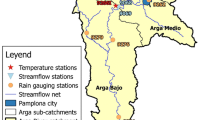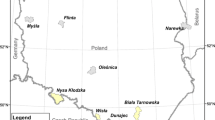Abstract
Climate projections point to modifications in the magnitude, frequency and timing of floods in the future. However, robust methodologies to quantify how climate change will modify the catchment response in flood events are required. Continuous hydrological modelling usually smooth magnitudes of extreme events. This paper proposes a methodology to improve the assessment of flood changes in the future driven by climate change. Climate change projections of the EURO-CORDEX programme obtained under the Fifth Assessment Report (AR5) of the Intergovernmental Panel on Climate Change (IPCC) supplied are used. Four catchments located on the Douro River Basin have been considered as case studies. Precipitation and temperature projections have been bias corrected to reduce errors with observations in the control period (1971–2004). The HBV continuous hydrological simulation model has been used to simulate the soil moisture content on the day of occurrence of the maximum annual rainfalls in the four catchments. The modified curve number method has been utilized to obtain the changes expected in the future in flood magnitudes, considering the initial soil moisture contents estimated with the HBV model and the expected changes in annual maximum rainfalls. The methodology has been applied to the control period (1971–2004) to check the validity of the process. Then, the methodology has been applied to the future period (2011–2095), to quantify the changes expected in the future in flood magnitudes under climate change conditions. The combined use of the HBV continuous hydrological simulation with the modified curve number method improves the results provided by the HBV model. The proposed methodology allows a better characterization of the response of catchments in flood events. It also considers the expected variation in the antecedent moisture content in catchments in the future, driven by increasing temperatures and decreasing mean annual precipitations in the future. The results show that flood quantiles will increase in three of the four catchments considered.











Similar content being viewed by others
References
Alfieri L, Burek P, Feyen L, Forzieri G (2015) Global warming increases the frequency of river floods in Europe. Hydrol. Earth Syst. Sci. 19:2247–2260. https://doi.org/10.5194/hess-19-2247-2015
Álvarez AJ, Mediero L, García C (2014) Review and selection of statistical models to fit maximum annual peak flows distribution function in Spain. Ing 104(174):5–31
Arnell NW, Reynard NS (1996) The effects of climate change due to global warming on river flows in Great Britain. J Hydrol 183(3–4):397–424
Bergström S, Carlsson B, Gardelin M, Lindström G, Pettersson A, Rummukainen M (2001) Climate change impacts on runoff in Sweden assessments by global climate models, dynamical downscaling and hydrological modelling. Clim Res 16(2):101–112
Blöschl et al (2017) Changing climate shifts timing of European floods. Science 357(6351):588–590. https://doi.org/10.1126/science.aan2506
Blöschl et al (2019) Changing climate both increases and decreases European river floods. Nature 573:108–111. https://doi.org/10.1038/s41586-019-1495-6
Boe J, Terray L, Habets F, Martin E (2007) Statistical and dynamical downscaling of the seine basin climate for hydro-meteorological studies. Int J Climatol 27(12):1643–1655. https://doi.org/10.1002/joc.1602
Dankers R, Feyen L (2009) Flood hazard in Europe in an ensemble of regional climate scenarios. J Geophys Res 114:D16108. https://doi.org/10.1029/2008JD011523
Dankers R et al (2014) First look at changes in flood hazard in the inter-sectoral impact model intercomparison project ensemble. Proceedings of the National Academy of Sciences 111:3257–3261. https://doi.org/10.1073/pnas.1302078110
Doroszkiewicz J, Romanowicz RJ, Kiczko A (2019) The influence of flow projection errors on flood Hazard estimates in future climate conditions. Water 11:49. https://doi.org/10.3390/w11010049
Durman CF et al (2001) A comparison of extreme European daily precipitation simulated by a global and a regional climate model for present and future climates. Quarterly Journal of Royal Meteorological Society 127:1005–1015
Garijo C, Mediero L (2018) Influence of climate change on flood magnitude and seasonality in the Arga River catchment in Spain. Acta Geophysica 66(4):769–790
Garijo, C, Mediero L. (2019). Quantification of the expected changes in annual maximum daily precipitation quantiles under climate change in the Iberian Peninsula. Proceedings, 7, 23. Proceedings of the 3rd international electronic conference on water sciences (ECWS-3)
Garijo C, Mediero L, Garrote L (2018) Usefulness of AEMET generated climate projections for climate change impact studies on floods at national-scale (Spain). Ingeniería del agua 22(3):153–166
Giuntoli I, Vidal JP, Prudhomme C, Hannah DM (2015) Future hydrological extremes: the uncertainty from multiple global climate and global hydrological models. Earth System Dynamics 6(1):267–285. https://doi.org/10.5194/esd-6-267-2015
Grimaldi S, Petroselli A, Romano N (2013) Green-Ampt curve-number mixed procedure as an empirical tool for rainfall–runoff modelling in small and ungauged basins. Hydrol Process 27:1253–1264. https://doi.org/10.1002/hyp.9303
Grimaldi S, Petroselli A, Serinaldi F (2011) Design hydrograph estimation in small and ungauged watersheds: continuous simulation method versus event-based approach. Hydrol Process 26:3124–3134. https://doi.org/10.1002/hyp.8384
Grimaldi S, Petroselli A, Serinaldi F (2012) A continuous simulation model for design-hydrograph estimation in small and ungauged watersheds. Hydrol Sci J 57(6):1035–1051. https://doi.org/10.1080/02626667.2012.702214
Haan CT, Barfield BJ, Hayes JC (1981) Design hydrology and sedimentology for small catchments. Academic Press, San Diego
Horton P et al (2006) Assessment of climate-change impacts on alpine discharge regimes with climate model, uncertainty. Hydrological Processes 20:2091–2109
IPCC (Intergovernmental Panel on Climate Change) (2007) Climate change 2007: impacts adaptation and vulnerability. Contribution of Working Group II to the Fourth Assessment Report of the Intergovernmental Panel on Climate Change. Cambridge University Press, Cambridge, UK, p. 976
Jacob D, Petersen J, Eggert B, Alias A, Christensen OB, Bouwer LM, Braun A, Colette A, Déqué M, Georgopoulou E (2014) EURO-CORDEX: new high-resolution climate change projections for European impact research. Reg Environ Chang 14:563–578
Khazaei MR, Zahabiyoun B, Saghafian B (2012) Assessment of climate change impact on floods using weather generator and continuous rainfall-runoff model. Int J Climatol 32:1997–2006. https://doi.org/10.1002/joc.2416
Kundzewicz ZW, Krysanova V, Dankers R, Hirabayashi Y, Kanae S, Hattermann FF, Huang S, Milly PCD, Stoffel M, Driessen PPJ, Matczak P, Quevauviller P, Schellnhuber HJ (2017) Differences in flood hazard projections in Europe – their causes and consequences for decision making. Hydrol Sci J 62(1):1–14. https://doi.org/10.1080/02626667.2016.1241398
Kundzewicz ZW, Pińskwar I, Brakenridge GR (2013) Large floods in Europe, 1985–2009. Hydrol Sci J 58(1):1–7. https://doi.org/10.1080/02626667.2012.745082
Leander R, Buishand TA, van den Hurk BJJM, de Wit MJM (2008) Estimated changes in flood quantiles of the river Meuse from resampling of regional climate model output. Journal of hydrology 351:331–343
Lehner B, Döll P, Alcamo J, Henrichs T, Kaspar F (2006) Estimating the Impact of Global Change on Flood and Drought Risks in Europe: A Continental, Integrated Analysis. Clim Chang 75:273–299. https://doi.org/10.1007/s10584-006-6338-4
Lenderink G, Buishand A, Van Deursen W (2007) Estimates of future discharges of the river Rhine using two scenario methodologies: direct versus delta approach. Hydrol Earth Syst Sci 11(3):1145–1159
Martins ES, Stedinger JR (2000) Generalized maximum-likelihood generalized extreme-value quantile estimators for hydrologic data. Water Resour Res 36(3):737–744
Michel C, Andréassian V, Perrin C (2005) Soil conservation service curve number method: how to mend a wrong soil moisture accounting procedure? Water Resour Res 410. https://doi.org/10.1029/2004WR003191
NRCS (2004). Estimation of direct runoff from storm rainfall. Part 630 hydrology National Engineering Handbook. Chapter 10. Natural Resources Conservation Service
Petroselli A, Grimaldi S, Romano N (2013) Curve-number/green-Ampt mixed procedure for net rainfall estimation: a case study of the Mignone watershed, IT. Procedia Environ Sci 19:113–121. https://doi.org/10.1016/j.proenv.2013.06.013
Rojas R, Feyen L, Dosio A, Bavera D (2011) Improving pan-European hydrological simulation of extreme events through statistical bias correction of RCMdriven climate simulations. Hydrol Earth Syst Sci 15(8)
Rojas R et al (2012) Assessment of future flood hazard in Europe using a large ensemble of bias-corrected regional climate simulations. J Geophys Res Atmos 117:D17109
Roudier P, Andersson JCM, Donnelly C, Feyen L, Greuell W, Ludwig F (2016) Projections of future floods and hydrological droughts in Europe under a +2°C global warming. Clim Chang 135(2):341–355. https://doi.org/10.1007/s10584-015-1570-4
Schmidli J, Frei C, Vidale PL (2006) Downscaling from GCM precipitation: a benchmark for dynamical and statistical downscaling methods. Int J Climatol 26(5):679–689. https://doi.org/10.1002/joc.1287
SCS (1985). National engineering handbook. Section 4-hydrology. Soil Conservation Service. Washington, DC
Seibert J, Vis M (2012) Teaching hydrological modeling with a user-friendly catchment-runoff-model software package. Hydrology and Earth System Sciences 16:3315–3325. https://doi.org/10.5194/hess-16-3315-2012
Shabalova MV, Deursen WPA, Buishand TA (2003) Assessing future discharge of the river Rhine using regional climate model integrations and a hydrological model. Climate Res 23:233–246. https://doi.org/10.3354/cr023233
Sherali HD, Driscoll PJ (2000) Evolution and state-of-the-art in integer programming. J Comput Appl Math 124:319–340
Smith A, Freer J, Bates P, Sampson C (2014) Comparing ensemble projections of flooding against flood estimation by continuous simulation. J Hydrol 511:205–219
Soriano E.; Mediero L.; Garijo C. (2018) Selection of bias correction methods to assess the impact of climate change on flood frequency curves. Proceedings of the 3rd international electronic conference on water sciences (ECWS-3). https://doi.org/10.3390/ECWS-3-05809
Soriano E, Mediero L, Garijo C (2019) Selection of Bias correction methods to assess the impact of climate change on flood frequency curves. Water 11:2266
Stephens CM, Johnson FM, Marshall LA (2018) Implications of future climate change for event-based hydrologic models. Adv Water Resour 119:95–110. https://doi.org/10.1016/j.advwatres.2018.07.004
Teutschbein C, Seibert J (2010) Regional Climate Models for Hydrological Impact Studies at the Catchment Scale: A Review of Recent Modeling Strategies. Geography Compass 4:834–860. https://doi.org/10.1111/j.1749-8198.2010.00357.x
Warrach-Sagi K, Schwitalla T, Bauer HS (2013) A regional climate model simulation for EURO-CORDEX with the wrf model. In sustained simulation performance 2013 (pp 147–157)
Acknowledgements
The authors acknowledge the Spanish Centre of Hydrographic Studies of CEDEX, the Agencia Estatal de Meteorología (AEMET) and the CORDEX initiative, especially the EURO-CORDEX project, for providing climate and hydrological data used in this paper. The authors also acknowledge that this study was partially supported by the projects CGL2014-52570-R ‘Impact of climate change on the bivariate flood frequency curve’ funded by the Spanish Ministry of Economy and Competitiveness and PID2019-107027RB-I00 ‘SAFERDAMS: Assessment of the impact of climate change on hydrological dam safety’ funded by the Spanish Ministry of Science and Research.
Author information
Authors and Affiliations
Corresponding author
Ethics declarations
Conflict of Interest
None.
Additional information
Publisher’s Note
Springer Nature remains neutral with regard to jurisdictional claims in published maps and institutional affiliations.
Rights and permissions
About this article
Cite this article
Soriano, E., Mediero, L. & Garijo, C. Quantification of Expected Changes in Peak Flow Quantiles in Climate Change by Combining Continuous Hydrological Modelling with the Modified Curve Number Method. Water Resour Manage 34, 4381–4397 (2020). https://doi.org/10.1007/s11269-020-02670-w
Received:
Accepted:
Published:
Issue Date:
DOI: https://doi.org/10.1007/s11269-020-02670-w




